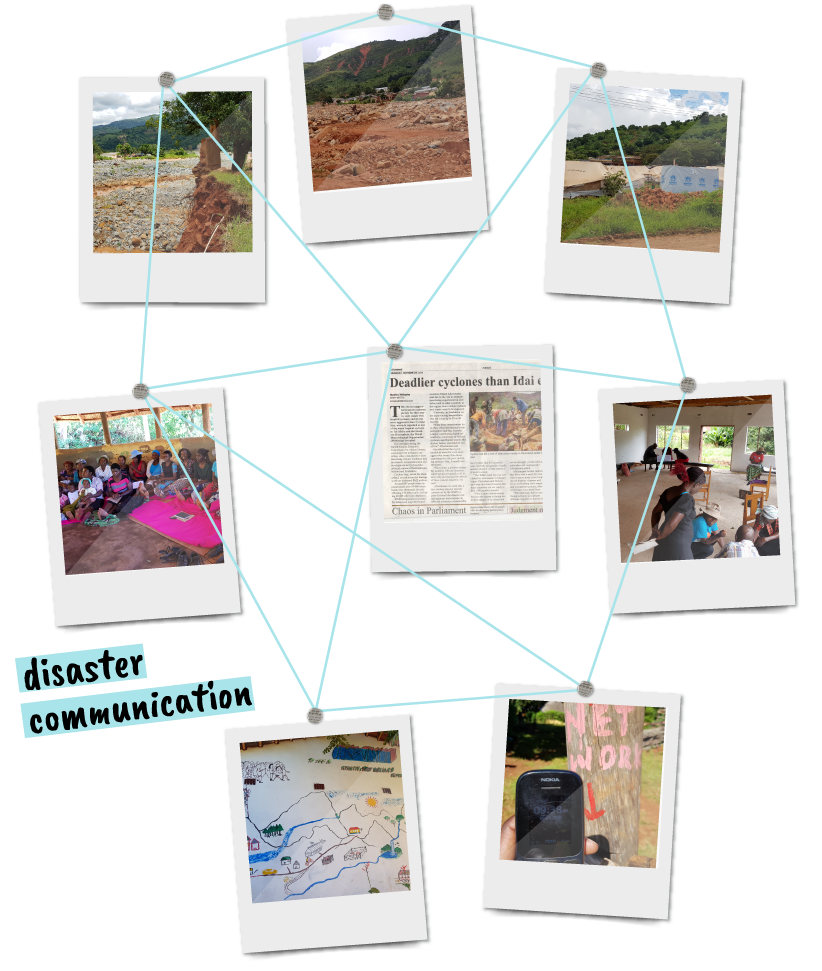RESEARCH/
Communication in times of disaster
This project investigates the potentials and pitfalls of mobile communication technologies to enhance early warning and disaster preparedness in Zimbabwe.
Disrupted communication flows in the context of Cyclone Idai
In March 2019, tropical cyclone Idai caused catastrophic damage in Madagascar, Mozambique, Malawi and Zimbabwe. With more than 1300 deaths and many more people missing, it ranks as the second-deadliest cyclone on record in Chimanimani District in Zimbabwe. While the news in Germany and other European countries were already forecasting the movement of the cyclone envisioning potential dangers and damages, most of the people in this part of Zimbabwe was still completely unaware. Even after the cyclone had hit large parts of the eastern highlands, the information about potential aid was distributed very unequally. This shows, that despite the proliferation of information and communication technologies (ICTs) in many parts of rural Africa, the distribution of information can still be disparate or disrupted. Thus, while ICTs have been celebrated by many as a means to enhance access to information and to “democratize knowledge” (e.g. Sanger 2009), incidents like cyclone Idai reveal the complexities of information flows. Considering the high vulnerability of rural communities to environmental disasters and the crucial role that access to information plays to increase disaster preparedness as well as response, this project therefore wishes to investigate the underlying politics of information flows in the context of disaster risk reduction (DRR) in Zimbabwe.
A critical engagement with disaster communication beyond the state
This observed lack of information from official institutions led to the emergence of community-based communication networks. Yet, while these generally fit current trends towards bottom-up approaches and the increasing relevance of social media use, empirical insights also reveal some of the “darker sides” of informal disaster governance, such as issues of mistrust and misunderstandings (Duda et al. 2020). Therefore, combining ethnographic research in four villages of the severely affected Chimanimani District, with interviewing experts involved in DRR in Zimbabwe, and an analysis of public debates in major online forums (e.g. twitter and Facebook), this project wishes to contribute to a better understanding of the role of different media to communicate disaster risk and response in rural Zimbabwe. The insights generated from this research are meant to contribute to a critical reflection on the potentials and pitfalls of ICTs for disaster preparedness more generally.
Everjoy Chiimba
Julia Verne
Project-related publications:
Chiimba, E. & Verne, J. (2022) Disaster communication beyond the state? Community Organisations, Informal Information Flows and the mediation of (mis)trust before and after Cyclone Idai in Zimbabwe, International Journal of Disaster Risk Reduction, Vol. 76, 103012.
Bertram, M. & Verne, J. (2021) Communicating with home, coping without home: Trusting to the mediating capacity of blogging, Digital Geography and Society 2, 100014.
Disrupted communication flows in the context of Cyclone Idai
In March 2019, tropical cyclone Idai caused catastrophic damage in Madagascar, Mozambique, Malawi and Zimbabwe. With more than 1300 deaths and many more people missing, it ranks as the second-deadliest cyclone on record in Chimanimani District in Zimbabwe. While the news in Germany and other European countries were already forecasting the movement of the cyclone envisioning potential dangers and damages, most of the people in this part of Zimbabwe was still completely unaware. Even after the cyclone had hit large parts of the eastern highlands, the information about potential aid was distributed very unequally. This shows, that despite the proliferation of information and communication technologies (ICTs) in many parts of rural Africa, the distribution of information can still be disparate or disrupted. Thus, while ICTs have been celebrated by many as a means to enhance access to information and to “democratize knowledge” (e.g. Sanger 2009), incidents like cyclone Idai reveal the complexities of information flows. Considering the high vulnerability of rural communities to environmental disasters and the crucial role that access to information plays to increase disaster preparedness as well as response, this project therefore wishes to investigate the underlying politics of information flows in the context of disaster risk reduction (DRR) in Zimbabwe.
A critical engagement with disaster communication beyond the state
This observed lack of information from official institutions led to the emergence of community-based communication networks. Yet, while these generally fit current trends towards bottom-up approaches and the increasing relevance of social media use, empirical insights also reveal some of the “darker sides” of informal disaster governance, such as issues of mistrust and misunderstandings (Duda et al. 2020). Therefore, combining ethnographic research in four villages of the severely affected Chimanimani District, with interviewing experts involved in DRR in Zimbabwe, and an analysis of public debates in major online forums (e.g. twitter and Facebook), this project wishes to contribute to a better understanding of the role of different media to communicate disaster risk and response in rural Zimbabwe. The insights generated from this research are meant to contribute to a critical reflection on the potentials and pitfalls of ICTs for disaster preparedness more generally.
Everjoy Chiimba
Julia Verne
Project-related publications:
Chiimba, E. & Verne, J. (2022) Disaster communication beyond the state? Community Organisations, Informal Information Flows and the mediation of (mis)trust before and after Cyclone Idai in Zimbabwe, International Journal of Disaster Risk Reduction, Vol. 76, 103012.
Bertram, M. & Verne, J. (2021) Communicating with home, coping without home: Trusting to the mediating capacity of blogging, Digital Geography and Society 2, 100014.
